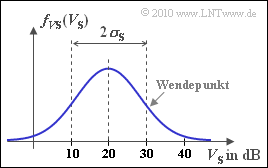Exercise 1.2: Lognormal Channel Model
We consider a mobile radio cell in an urban area and a vehicle that is approximately at a fixed distance $d_0$ from the base station. For example, it moves on an arc around the base station.
Thus the total path loss can be described by the following equation: $$V_{\rm P} = V_{\rm 0} + V_{\rm S} \hspace{0.05cm}.$$
- $V_0$ takes into account the distance-dependent path loss which is assumed to be constant: $V_0 = 80 \ \rm dB$ .
- The loss $V_{\rm S}$ is due to shadowing caused by the lognormal–distribution with the probability density function (PDF)
- $$f_{V{\rm S}}(V_{\rm S}) = \frac {1}{ \sqrt{2 \pi }\cdot \sigma_{\rm S}} \cdot {\rm exp } \left [ - \frac{ (V_{\rm S}- m_{\rm S})^2}{2 \cdot \sigma_{\rm S}^2} \right ] \hspace{0.05cm}$$
- see diagram. The following numerical values apply:
$$m_{\rm S} = 20\,\,{\rm dB}\hspace{0.05cm},\hspace{0.2cm} \sigma_{\rm S} = 10\,\,{\rm dB}\hspace{0.15cm}{\rm or }\hspace{0.15cm}\sigma_{\rm S} = 0\,\,{\rm dB}\hspace{0.15cm}{\rm (subtask\hspace{0.15cm} 2)}\hspace{0.05cm}.$$
Also make the following simple assumptions:
- The transmit power is $P_{\rm S} = 10 \ \rm W$ (or $40 \ \rm dBm$).
- The receive power should be at least $P_{\rm E} = 10 \ \rm pW$ (or $–80 \ \rm dBm$)
Notes:
- This task belongs to the chapter Distanzabhängige Dämpfung und Abschattung.
- You can use the following (rough) approximations for the complementary Gaussian error integral:
- $${\rm Q}(1) \approx 0.16\hspace{0.05cm},\hspace{0.2cm} {\rm Q}(2) \approx 0.02\hspace{0.05cm},\hspace{0.2cm} {\rm Q}(3) \approx 10^{-3}\hspace{0.05cm}.$$
- Or use the interaction module provided by $\rm LNTwww$ Komplementäre Gaußsche Fehlerfunktionen.
Questionnaire
Sample solution
- From the $\rm dB$–value $V_0 = 80 \ \rm dB$ follows the absolute (linear) value $K_0 = 10^8$. Thus the received power is
$$P_{\rm E} = P_{\rm S}/K_0 = 10 \ {\rm W}/10^8 = 100 \ {\rm nW} > 10 \ \ \rm pW.$$
- You can also solve this problem directly with the logarithmic quantities:
- $$10 \cdot {\rm lg}\hspace{0.15cm} \frac{P_{\rm E}}{1\,\,{\rm mW}} = 10 \cdot {\rm lg}\hspace{0.15cm} \frac{P_{\rm S}}{1\,\,{\rm mW}} - V_0 = 40\,{\rm dBm} -80\,\,{\rm dB} = -40\,\,{\rm dBm} \hspace{0.05cm}.$$
- Only the limit value $–80 \ \rm dBm$ is required.
(2) Lognormal–Fading with $\sigma_{\rm S} = 0 \ \rm dB$ is equivalent to a constant receive power $P_{\rm E}$.
- Compared to the subtask '(1) this is $m_{\rm S} = 20 \ \ \rm dB$ smaller ⇒ $P_{\rm E} = \ –60 \ \ \rm dBm$.
- But it is still greater than the specified limit value ($–80 \ \rm dBm$).
- It follows: The system is (almost) 100% functional. „Fast” because with a Gaussian random quantity there is always a (small) residual uncertainty.
(3) The receive power is too low (less than $–80 \ \rm dBm$) if the power loss due to the lognormal–term is $40 \ \rm dB$ or more.
- The variable portion $V_{\rm S}$ must therefore not be greater than $20 \ \rm dB$.
- So it follows:
$${\rm Pr}({\rm "System\hspace{0.15cm} does not work\hspace{0.15cm}"})= {\rm Q}\left ( \frac{20\,\,{\rm dB}}}{\sigma_{\rm S} = 10\,{\rm dB}\right ) = {\rm Q}(2) \approx 0.02\hspace{0.3cm} \Rightarrow \hspace{0.3cm}{\rm Pr}({\rm "System\hspace{0.15cm} works"})= 1- 0.02 \hspace{0.15cm} \underline{\approx 98\,\%}\hspace{0.05cm}.$$
The graphic illustrates the result.
- The probability density $f_{\rm VS}(V_{\rm S})$ of the path loss due to shadowing (Longnormal–Fading) is shown here.
- Die Wahrscheinlichkeit, dass das System ausfällt, ist rot markiert:
(4) Aus der Verfügbarkeitswahrscheinlichkeit $99.9 \%$ folgt die Ausfallwahrscheinlichkeit $10^{\rm –3} \approx \ {\rm Q}(3)$.
- Verringert man den entfernungsabhängigen Pfadverlust $V_0$ um $10 \ \rm dB$ auf $\underline {70 \ \rm dB}$, so kommt es erst dann zu einem Ausfall, wenn $V_{\rm S} ≥ 50 \ \rm dB$ ist.
- Damit wäre genau die geforderte Zuverlässigkeit erreicht, wie die folgende Rechnung zeigt:
- $${\rm Pr}({\rm "System\hspace{0.15cm}funktioniert\hspace{0.15cm}nicht"})= {\rm Q}\left ( \frac{120-70-20}{10}\right ) = {\rm Q}(3) \approx 0.001 \hspace{0.05cm}.$$
- The probability that the system will fail is marked in red:
(4) From the availability probability $99.9 \%$ follows the default probability $10^{\rm –3} \approx \ {\rm Q}(3)$.
- If the distance-dependent path loss $V_0$ is reduced by $10 \ \ \rm dB$ to $\underline {70 \ \rm dB}$, a failure will only occur when $V_{\rm S} ≥ 50 \ \ \rm dB$.
- This would achieve exactly the required reliability, as the following calculation shows:
$${\rm Pr}({\rm "System\hspace{0.15cm} does not work\hspace{0.15cm}"})= {\rm Q}\left ( \frac{120-70-20}{10}\right ) = {\rm Q}(3) \approx 0.001 \hspace{0.05cm}.$$

